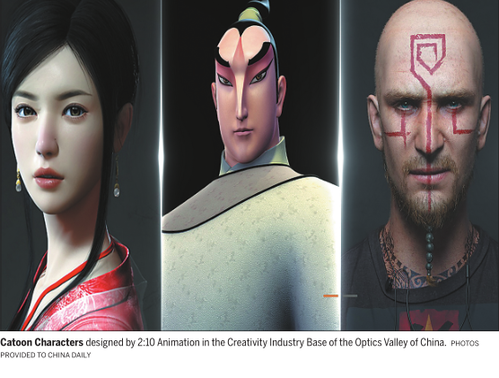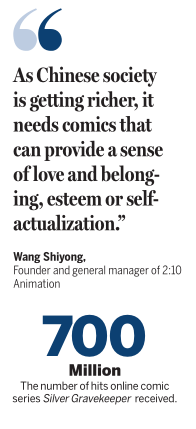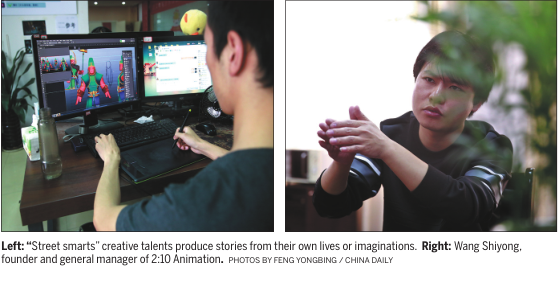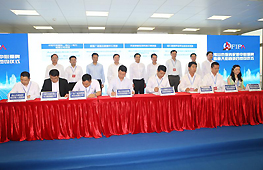Young talent fuel valley's creative industry with enthusiasm

As the Chinese economy enters the new normal with its growth rate slowing, innovation has been placed at a core position in China’s overall development. China Daily recently interviewed people involved with a leading State-level innovation pilot zone, Optics Valley of China in Wuhan. This series of reports will use the valley’s case as an example of what China has done to boost innovation and the difficulties and challenges faced.
When emoticons and any-mated images were appearing everywhere in online chat platforms in 2006, fueling a demand for more such symbols, Wang Shiyong thought that developing such products required a “deeper understanding of the comic industry”.
The pack of images his company subsequently offered is called“Lucky Boy”, in which a money-giving boy in traditional Chinese outfit and his friend, a little drag-on girl, distribute luck and wealth.

The idea became a best-seller, not only topping the list of the most down-loaded images but also authorized to appear else-where on such products as credit cards, phone cases, postcards, snack packages and online shopping campaigns.
“We created the image of Lucky Boy to be the utmost auspicious sign of China,” said Wang, the owner and general manager of 2:10 Animation in the Creativity Industry Base of the Optics Valley in Wuhan.
“People buy things because of an appeal. The image we created must arouse a world that matches what’s in the customers’ mind. That is cultural appeal.”

Wang believes it is the successful association of the word “lucky” with the boy’s image that resonates with viewers and led to the popularity of the series —a business model similar to the Japanese fi coronal character Hello Kitty and missing in the Chinese market then.
According to Wang, the case of Lucky Boy reflects a growing demand for cultural appeal in comics.
“Comics and animations in China were used to free parents from babysitting in the past, or addressing the physiological issue. Then we realized many of them are full of violence or fi lathy word-in, meaning they can’t address safety needs,” Wang said.
“As Chinese society is getting richer, it needs comics that can provide a sense of love and belong-in, esteem or self-actualization, ”he said, adding that leaders of the industry in the US and Japanese markets have been cashing in on those higher needs and have there-fore successfully sold out superhero-themed products.
Determined to ride that same wave, Wang’s company began transformation in 2013 “to things that will become popular in the next three years”.
His second brainchild, the online comic series Silver Grave-keeper, took off in 2015.
The comic has recorded more than 700 million aggregated hits so far and boosted the company to receive its latest round of fi nuancing from venture capital investors of 10 million yuan ($1.52 million) in March.
Silver Grave keeper has been developed into a mobile game approve the same name and a Japanese company is set to fi knish editing an animated fi lm based on the comic by 2017.
Besides addressing audience needs for self-actualization, Wang said another key to the company’s success is that his team is com-prized of mostly 18-year-olds, some of whom did not go to col-leg but only professional schools but possess “street smarts”.
“The creative team is young and produces stories from their own lives or imaginations. This can’t be done by people in their 40s or 50s,” he said.
Wang’s company is not the only one to benefit t from the out-of-the-box thinking of young talents in Wuhan, a city that has had the largest number of students of higher education, 1.18 million, in the world since 2014.

The comics and animation industry has developed over 10years in Wuhan and Wang’s com-pay is not the only one to succeeding the Creativity Industry Base of Optics Valley of China in Wuhan.
Local authorities published an implementation plan to develop the industry with pilot projects in 2012. The base so far has four comic and animation companies listed for stock trading and its out-put reached 5 billion yuan in 2015.
“The achievement and development fully demonstrates that Optics Valley has nurtured vital-it for the comic and anima-ton industry,” said Zhang Min, director of the Wuhan Comic and Animation Association.
Contact the writers through wanghuazhong@chinadaily.com.cn





















